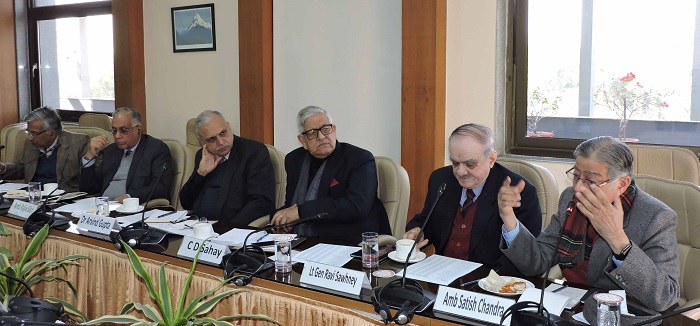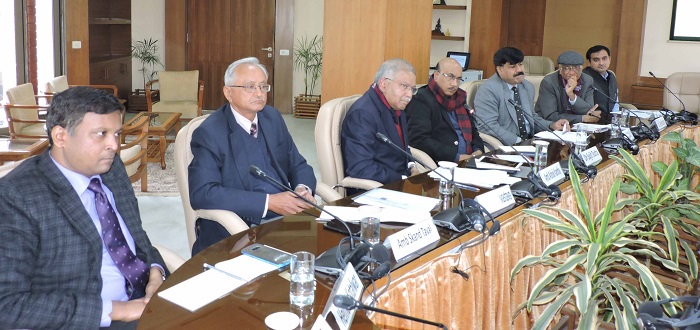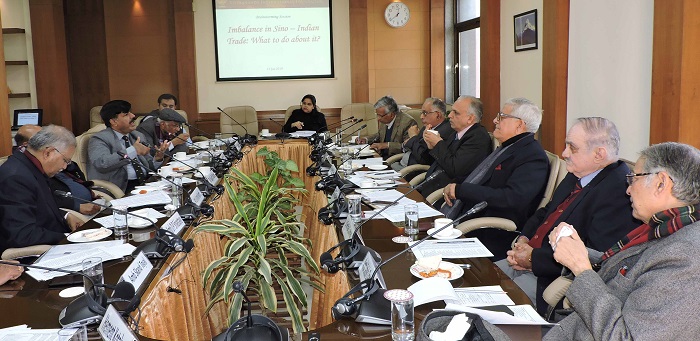The Vivekananda International Foundation (VIF) organised a brain storming session on the topic of ‘Imbalance in Sino-Indian Trade: What to do about it?’ Dr. Arvind Gupta, Director, VIF, delivered the opening remarks. The session was attended by the members of the strategic community, eminent diplomats, members of strategic community and policy-makers dealing with China. Among the attendees were; Sanjay Chadha (Joint Secretary, Ministry of Commerce), Hemant Kotwani (National Security Council Secretariat, NSCS), Amb. Skand Tayal, Amb. Ashok Kantha, Mr. V Sheshadri, Dr. Suresh Goel, Amb. Rajiv Sikri, Amb. Satish Chandra, Lt Gen Ravi Sawhney, Mr. C. D Sahay, Prof. Sujit Dutta and Dr. Venkateshwar (NSCS). Salient points that emerged from the discussions are as described below.

The Main Issue
The trade deficit has plateaued at a high level over last six years. It is the third highest after the trade deficit of the US and the Netherlands with China. If it continues it is likely to become nearly USD 70 billion this year. Imports from China are growing rapidly, while exports from India are stagnant. The situation has become unsustainable. The main reason for this is the composition and structure of the trade. At present 90 percent of the active pharmaceutical ingredients (API) in the pharmaceutical sector and 87 percent of the solar panels are coming from China. If the domestic demands of China for these products increase, it will have effect on the Indian market.
Presently, China has dominance in the pharmaceutical and solar panel industries. India imports fermentation based API worth USD 2 million. In 1980, there were two public sector undertakings (PSU) manufacturing API. China has invested heavily in its research and development sector. Consequently, they brought down the cost of APIs and the Indian PSU’s had no option but to shut down in the face of cheaper Chinese imports.
There is growing concern in the country on the staggering trade deficit with China. India has 11500 products on the Harmonised System (HS) code classified into broad 85 commodities. Among them, 16 commodities constitute 90 percent of our import. The telecom sector constitutes USD 11 billion in imports which alone is more than our total export to China.
The moot question is: How can we reduce the increasing trade deficit without hampering our own market?

RCEP and India-China
It is difficult to deal with China at the bilateral level. Hence we need some multi-lateral platform to deal with the issue. At the multi-lateral level, India and China are engaged in Regional Comprehensive Economic Partnership (RCEP) and Asia-Pacific Trade Agreement (APTA). The main problem for India in dealing with RCEP is to handle China. India already has Free Trade Agreement (FTA) with many of the RCEP countries. The dominance of China in Indian industries is already growing at rapid speed, e.g., that of steel, aluminium and copper. The Indian industry is concerned about the unhindered flow of goods from China. FTA, with no duties on most products, would increase the deficit significantly. Evidently, in RCEP China is our main concern.
Challenges
China may use trade as a tool to pressurise India as it did with South Korea. The Lotte Group had to sell some of its Chinese stores in the face of crippling measures imposed by Beijing over Seoul’s participation in the US missile defence system. About 80 percent of the 112 Lotte Mart stores in China were closed for more than six months as authorities tightened safety and sanitary inspections and consumers boycotted them, costing Lotte hundreds of millions of dollars.
Trade in India does not receive sufficient political attention. In Bangladesh, any issue with the apparel industry is raised in the Parliament. Thus, creating political consciousness for improving the political trade profile is essential. India should also leverage the size of its market. In this process, the main challenge for India is going to be in shifting production from China to India, for which there is certainly a need to diversify. Chinese are inclined to manufacture in India, the rising Chinese FDI in India is a testimony to it. Chinese leverage vis-a-vis India on trade at present is limited. It may be unlikely that Chinese would use trade as a method of coercion, but they have tried it with Japan, South Korea and the Philippines earlier. One has to be very careful while dealing with China. Seemingly, China had given a clearance for Basmati Rice. Later on, it was discovered that there is no market for it. In addition, the Chinese companies offer competitive prices for project finance and often use irregular methods to get a project. China gives aid even to buy its own products. India has expressed concerns over the Belt and Road Initiatives (BRI) and has not endorsed it. On the other hand, by not joining BRI are we missing out the connectivity projects remains an issue.
Evidently, there is a strategic dimension to the increasing trade deficit and India has to build its own capacities. It has to be very selective and careful in its strategy for opening the capital market.

Recommendations
For last three years, India has been successful in imposing ban on Chinese fire-crackers. Efforts have been made in the toy sector also. India has increased the toxic level standards for toys and hence has been able to limit the entry of Chinese toys. However, the toy sector is a very small portion of India-China trade. India needs to devise measures that are compatible with the World Trade Organisation (WTO) norms and has to come up with general standardisation that is also applicable to the domestic market. Restrictions on Chinese products have to come up in a nuance fashion.
The other way to deal with the deficit is to get better access to the Chinese market. India has to expand her wish list vis-à-vis China for better access to its market and insist on a broad trade agreement based on reciprocity. While manufacturing and energy cost of industries is much more competitive, the labour cost within China is rising. At this juncture India has an advantage over China in some labour incentive areas and other areas of trade that it can nurture. India has to think in terms of value addition to the products within the country rather than exporting the raw materials and then importing the finished products, as in the steel and aluminium sectors. There is a need to start the process of value addition within the country. There is a need to incentivise the producers.
Indian companies cannot manufacture everything nor should they aspire to do that. We should encourage competition and identify sectors that are strategic, for example steel and auto industry. A well-thought-out strategic policy should be implemented for these sectors. All our anti-dumping duties on Chinese goods are on chemicals. As a strategy, the Indian government should try to convince the industries to raise anti-dumping cases.
India needs Projects such as Sagarmala to diversify Indian trade projects. The vision of the project is to reduce logistics cost for Export–Import (EXIM) and domestic trade with minimal infrastructure investment. It entails reducing the cost of transporting domestic cargo by optimising modal mix, lowering logistics cost of bulk commodities by locating future industrial capacities near the coast, improving export competitiveness by developing port-proximate discrete manufacturing clusters and optimising time-cost of EXIM container movement.
The alternative to come out of the trap is not in just thinking in terms of trade but as to how to reduce our dependence on critical infrastructure of China and diversify our dependence. In a way, dependence is bad; it kills the indigenous industries. India should increase its investment in Africa and step up collaborations with Japan. Incentive should be given to the start-up companies. Foreign Direct Investment (FDI) policy for manufacturers in India should prevent monopoly and dominance of a particular country, especially China; it should be as low as 25 percent dominance by any particular country/ entity.
Finally, I was pointed out that while doing business, nobody thinks of strategy. Yet, there is a need to have a long-term strategic outlook to deal with the high and constant trade deficit with China. There is a need to focus on innovation. China has already taken a lead in the pharmaceutical and solar sectors. Hence, we should take steps to safeguard our other industries. The policies of the automobile sectors are worth emulating. India should invest in institution building and help to create a critical mass, strong research and development and industries within the country.


